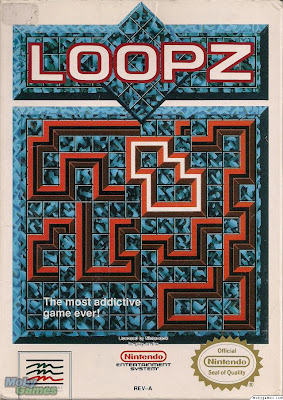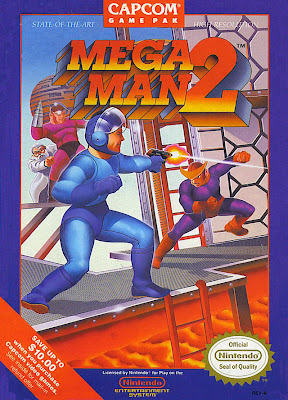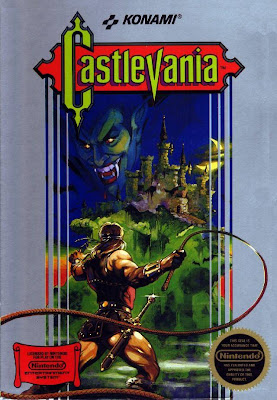The Short
Pros
- Fun, extremely simple puzzle game
- Simply make complete pathways to earn points
- Piece complexity quickly ramps up
- Difficulty settings help keep it fun
Con
- Absolutely atrocious color scheme
- Equally atrocious music; ugh.
- "Easy" will never end; it's way too easy
- Never adds anything particularly unique to the formula
 |
| Are you ready to LOOPZ?! |
The Long
Apparently Loopz is "the most addicting game ever." Weird, I thought that was Diablo 3, but what do I know?
Anyway, I originally played Loopz on some weird game compilation disc that came with our 486-66 computer way back in the day. I've been searching for the name of this game for years since, and only recently finally found it out. Considering the PC version won't run on anything anymore, I opted for the NES version, ready to relive classic memories of making LOOPZ.
Alas, while this was the game I played rather studiously growing up, it seems twenty years will do a lot for one's opinion.
 |
| This is really the best color scheme they could come up with. |
The concept of Loopz is actually simple but quite addicting (the box didn't lie!). Essentially, you have a small grid which to put pieces on. The game randomly gives you various pieces (and there is no "next piece" like in Tetris) and your goal is to make a complete "loop" out of them (read: a complete connection). Partial connections just clutter up your space, until eventually you run out of room. On the bottom is a timer to place each piece. If you fail to drop a piece in time, you lose a life and it goes to the next one. Lose all your lives, and you're done. Simple enough, right?
If this sounds simple it's because it really is. The pieces get weirder and more complex, adding to the challenge, but Loopz never "throws you for a loop" (ha. PUNS.). It's just the same thing. Which, considering this is just a simple puzzle game (and you can get this game for like $2), I'm fine with that. It actually is pretty addicting, and having a loop-in-progress plan come into fruition can be very satisfying.
It's just too bad all the packaging for this fun concept is utter garbage.
 |
| All these screenshots are gonna look really similar... |
First off, the game looks pretty freaking hideous. I mean, look at it. Ugly dark green, lots of wasted black space, and that weird tan/red for placed pieces. Way to be. What is far worse, however, is the piece placement. It colors the pieces a weird purple/magenta and white, which not only contracts putrid, but on the smaller pieces the shading is so bad it takes a while to figure out exactly which direction the corner is. Spinning it doesn't help, so at first you'll get a lot of messed up pieces. Luckily your brain eventually adapts to the awful graphics and it becomes fun, but seriously? The PC version I played had a gray/white background with very crisp brown pieces. I never had any issues knowing which way pieces were going.
Whatever you do, don't listen to Tune A (first on this sound collection). It's so...bad.
The music is also pretty obnoxious. Tune A (the default song) is absolutely, ear-bustingly obnoxious with its high-pitch whining. The other two songs are ok (I like that Tune C is super catchy), but still are a far cry from the Tetris theme. Just make sure you change the song. Again, the PC version sounded much better in my recollection.
Lastly, the game just...has no sense of progression. Essentially you can pick your game mode at the start (all three are almost exactly the same), your music (don't pick Tune A), and then your difficulty level (0-9. Don't pick 0). The only difference in difficulty level is the time you have to drop a piece. The main issue is that, while you do get more complex and harder pieces as you advance, you can never bump up to a new difficulty stage. You know how in, say, Tetris the better you play the harder it gets until you finally lose? That's a good idea; it keeps you from being trapped in easy level limp. Loopz is easy level limbo. Once you master the difficulty level you are on, it's over. You'll never die. The only way to quit is to turn off the NES or throw the game. No sense of challenge.
Also, "A" is spin piece and "B" is place, the opposite of like every other game in the world. Way to go, Mindscape.
 |
| The lack of being able to see which piece is next also axes a lot of strategy. |
Do I still recommend Loopz? Well...yes, actually. While the core gameplay is repetitive and the game looks like ass, it's still...decent. I dunno. Maybe I'm being influenced here because I was so excited to finally find out the name of this game and then find a copy for cheap that I'm trying to justify its existence.
Eh, screw it, this game isn't very good. It's a few minutes of mindless puzzle fun but really it's just shallow and dull. While I'd still suggest grabbing it if you can find it for $2-3, don't go out of your way or anything.
One out of five stars. Curse you, childhood.
 |
| Ah, PC version. With actual progression. You look...actually not much better. My childhood is a lie! |








































